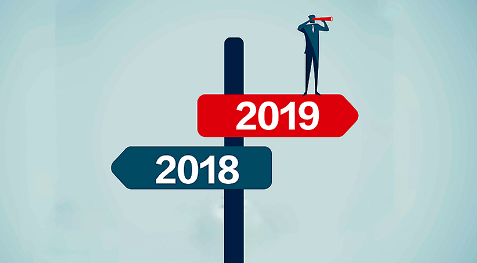If 2018 left you breathless and exhausted, then brace yourself as, sorry to say, things aren’t likely to slow down in 2019. Business leaders, authors, journalists and academics foresee a shaky economy, a troubled world order and continued global anxiety. But on the good side there’s a likely renewed focus on caring for ourselves, for each other and for generally doing the right thing. Here’s a look at the year ahead for 2019.
1. Generation Z reaches the workplace. During 2019 Generation Z, which Pew Research Center defines as those born from 1997 onward, will outnumber Millennials. “Generation Z is now heading into the workforce in meaningful numbers and for the first time in modern history five generations will be working side-by-side,” says Michael Dell, CEO and chairman of Dell Technologies. Gen Z will be about one-third of the global population and one-fifth of its workers. But what is this new generation’s work ethic? “My experience is that they lean in and lean hard,” says best-selling author Brené Brown. About half of her staff is now Gen Z. “They are all very different people, but as a group I experience them as curious, hopeful, always learning, painfully attuned to the suffering in the world, and anxious to do something about it.” And there are other trends too, with the young generation Z shying away from credit cards and debt and declining to own homes, this will undoubtedly make them better placed to cope with any future downturn in the global economy or business fortunes.
2. The economy will slow down, again. Economists are split on when exactly but they know one thing for sure, a downturn is coming. “There is a confluence of deep-seated, structural headwinds that threaten to upend the global economy,” warns economist Dambisa Moyo, among them growing inequality, a workforce ill-adapted to rapid technological change, political instability and a massive debt burden on governments, corporations and individuals. “The US has historically been the leader, and the US is probably going to slow down this year,” adds CBS News business analyst Jill Schlesinger. China is already cooling. “World growth is much more likely to slow down in 2019, and it really looks like 2020 could be the year of a global recession,” she predicts. And, of course, there’s Brexit in the UK…
3. Companies will prepare for a downturn with pre-emptive layoffs. Executives know the good times won’t last and many will reduce their workforce pre-emptively to preserve profits through a coming recession, warns Danielle DiMartino Booth, author of ‘Fed Up.’ General Motors announced 14,000 strategic layoffs in November, after 2,250 had already taken buyouts. Meanwhile, Verizon will let go of 10,400 employees via voluntary severance, the company announced Monday. These won’t be the last. “I guarantee you right now, consultants across the country are convening and discussing with executive teams at many companies what they also can do to get in front of the next recession,” Booth says. “Companies are taking unusual steps because they know how very long in the tooth this expansion is and they know what’s to come.”
4. We are finally going to spend more time online than watching TV. The lines will cross some time in 2019: Around the world, people will start spending more hours a day on the Internet than watching television. The glass-half-empty way to look at it is people are turning away from legacy media, says Viacom President and CEO Bob Bakish. The glass-half-full vision: “There is more content being consumed today than ever before in history,” he adds. For Viacom, that has meant expanding its intellectual property across many platforms or creating shows for third-party streaming sites. “We do work with folks that maybe didn’t exist 10 years ago, and started getting into the media business five years ago,” he says. “It’s a year of a mixed economy and a mixed ecosystem. And that’s the world of the future.”
5. Brexit will continue to consume the European political scene. Brexit should have been the most predictable geopolitical event of 2019, as we’ve known for two years the clock runs out at the end of March 2019. Instead, it continues to defy predictions. Negotiations will be uncertain to the very last minute, Ian Bremmer, president of Eurasia Group, warns. “Prime Minister Theresa May now needs to be thinking about plan B, since she’s lost so many members of parliament,” he says. A revamped “Norway plus” deal is becoming the most likely outcome, but the tail risks of a no deal Brexit or a second referendum are also increasing, he adds. “It is really, really hard to come to terms to negotiate something this complicated with one of the most challenging supranational institutions in the world, the EU, and one of the most dysfunctional developed governments in the world today, the UK.” Writing any more about Brexit at this point would just be handing over the stick we’ll all be beating each other with in the next three months.
6. CEOs will work hard to become more inclusive leaders. The new generation of younger workers expects a different kind of leadership and has now reached the critical mass where their opinion is corporate law. The interesting challenge for the business workplace is that workers are now less tolerant of poor management, staying in what they perceive as uninteresting roles for long periods, or working for companies that don’t in some way do their bit for the planet and other people. “We were primarily led by ‘my way or the highway’ type leaders and that does not work with this environment,” says Carla Harris, vice chairman and managing director at Morgan Stanley. “I think you’re going to see more leaders looking for leadership development or leadership guidance on how to be more collaborative, how to spur innovation, how to teach people how to fail and how to innovate. I think you’re going to see far more money spent on speakers and resources around that.” Not immediately, but over time executives who don’t make that effort and pivot will be pushed out, she warns.
7. Artificial intelligence (AI) will be in every industry and every job. When 200 LinkedIn Top Voices were asked about their Big Idea for 2019, one in four mentioned some application of AI, from parsing evidence in medical research to helping surfers spot the best wave. Six of the 15 hot emerging jobs of the past year, relate to AI, while AI skills are the fastest-growing on our platform, up 190% globally from 2015 to 2017. “While 2018 was the year of AI hype, it feels like we’re at an inflection point where these technologies are being incorporated into more of the tools we use everyday,” says Sharon O’Dea, co-founder of communications consultancy Lithos Partners. “It’s when technology trends start to become invisible that they really make a major impact.”
8. Silicon Valley in no longer the golden child it was. “The ire progressives once felt toward the 1% on Wall Street is turning on Silicon Valley,” says Redfin CEO Glenn Kelman. “Where tech leaders were once hailed as the visionaries of a brave new world, viewed as a breed apart from financiers and other plutocrats, we’re now finding ourselves mired in debates over taxes, housing and affordability.” Not everyone will camp outside headquarters in Mountain View or Menlo Park, but users will vote with their feet, deleting accounts and refusing to play their part in those companies’ business models, warns customer experience expert Don Peppers. “More people than ever will install and use ad blockers, decline surveys and opt out of cookies as 2019 develops into a banner year for privacy protection apps, data blockers and other security services,” says Peppers.
9. Governments will seize the opportunity to regulate Big Tech. Local and national authorities are seeking to impose new taxes and regulations on the industry. After years of failing to get them to pay their way on the business they actually do in Europe and frustration on the lack of unification of digital taxes, the EU is keen to bring in taxation on Silicon Valley. Traditional companies pay on average 23% tax in the EU, yet digital companies pay only 8% or 9%. Many governments plan to introduce a ‘digital tax’ of a percentage of tech companies’ revenue in their own countries, fighting back against US tech giants that evade taxes by domiciling their profits in Ireland or the Netherlands. During 2018 the EU wasn’t able to agree the tax level on turnover, so now individual member states are pushing forward with their own digital taxes. Five European countries have, or plan to have, a 2% to 6% tax on digital company turnover before 2020. It’s interesting that France already has the tax in place and Google is complying with it, as well as France and Germany taxing digital aids, aimed at Facebook and Google. India, South Korea, Mexico, Chile and others are all working on a similar tax based on the same idea, following the OECD promise of global taxation reform. European governments are also likely to turn to antitrust, predicts Emily Taylor, CEO of Oxford Information Labs. “We will rediscover competition law and regulation as a way of combating over-concentration of power and distortions in the market,” she says. It’s something the US has shied away from, not wanting to stifle its own innovative companies, but Europe has fewer giants and freer hands. “Smarter companies will help shape regulation rather than obstinately oppose it”, says Booking.com CEO Gillian Tans.
10. Automation will disproportionately impact women’s jobs. Christine Lagarde, managing director of the International Monetary Fund said, “New technologies like artificial intelligence and machine learning are changing the way work gets done all over the world. The automation trend is especially challenging for women because they tend to be employed in more routine tasks than men across all sectors and occupations, making them more prone to automation. New IMF research estimates that 26 million women’s jobs in 30 countries are at high risk of being displaced by technology in the next 20 years. This means 180 million women’s jobs globally! We don’t have much time to act, so 2019 is the year to make important inroads in tackling this challenge. How? We must help women get the skills they need to succeed. Education and training will be key — including greater emphasis on lifelong learning and STEM. Think, in particular, of coding programs like Girls Who Code in the US or developing tax deductions for training as they do in the Netherlands. We also need to close gender gaps in leadership positions across all sectors, while doing more to help men and women combine work and family life. Finally, we need to do a better job at bridging the digital divide and ensure women have equal access to finance, bank accounts and connectivity. 2019 is the year we should take a leap forward in levelling the playing field between men and women.”
11. The high street will band together. The story is repeating itself in every country, from the high street chains of the UK to the famed big box stores of America, where physical retailers buckle as they face deep-pocketed online disruptors, many paying ultra-low taxes. “Things have never been more competitive,” says entrepreneur Naomi Simson, CEO of the Big Red Group in Australia, where Amazon launched with fanfare just a year ago. But smaller players are starting to band together to stand up to the giants, she says. “It might be through buying groups, marketplaces, associations, movements such as ‘buy local’. There will also be M&A,” she predicts. “The difference now is mind-set. Business owners used to think the shop next door was competition. Now they know that there is safety in numbers.”
12. The battle against extreme poverty will heat up. Over the last 25 years, more than a billion people have lifted themselves out of extreme poverty, and the global poverty rate is at its lowest level in recorded history. However, that trend may not continue into 2019 due to increasing poverty concentrations in areas like Sub-Saharan Africa, says Melinda Gates, co-chair of the Bill & Melinda Gates Foundation. “We can’t always change the circumstances a child is born into, but we can invest in that child’s potential to thrive in spite of them by investing in their health and education,” says Gates. “Economists call health and education ‘human capital,’ because they’re proven to be the twin engines of economic growth.” Especially important, she argues, is investing in the health and education of women and girls. “Healthy, economically-empowered women are some of development’s best allies,” says Gates. “If the number of people trapped in poverty continues to decline, these women will be a big reason why.”
13. A US / China cold war will be fought on a technology front. Despite current tensions, the US and Chinese economy are too interlinked for a trade war to truly escalate in the short term, says Eurasia Group President Ian Bremmer. A cold war is more likely in five or 10 years, he adds, when an economic downturn and sustained animosity have undone those ties. But for 2019, the fight is on the technology front: “There you do have a cold war. There you have the Chinese with their AI model, the Americans with our AI model. The Chinese with their internet, the Americans with our internet,” he says. He echoes former Google CEO Eric Schmidt, who warned in September that our online world risked a “bifurcation” into Chinese-led and U.S.-led internets. “They’re not playing nice at all,” Bremmer adds. “I do think that longer term we’re heading for big trouble between the Americans and the Chinese.”
14. What will matter at work is your humanity. When robots take all our jobs, what do humans have left? Precisely that, our humanity. Creativity and so-called soft skills are becoming all the more important to your career because that’s what can’t be automated. In fact, LinkedIn data shows the fastest-growing skills gaps, the difference between what employers seek and what workers bring to the table, are related to soft skills. Oral communication tops the list, followed by people management, time management or leadership. Employers who want to make the most of their human employees make sure to look after them as whole people, not just task performers, says Susan Cain, author of “Quiet” and CEO of Quiet Revolution. “I’m increasingly seeing employers having a goal of facilitating the entire life of an employee,” Cain says. “I don’t mean it in a Big Brother type of way, but being an aid in the entire life of an employee as opposed to just the part that shows up to make wages.”
15. The combustion engine will get smarter before it goes away. Going green doesn’t have to be reserved for the wealthy who can afford to switch to an electric car, says Bertrand Piccard, chairman and pilot of Solar Impulse, who flew a solar plane around the planet. For middle class people struggling to fill up the tank, given the Yellow Vest protests in France, there are solutions. He points to an anti-smog device installed on the engine for a few hundred pounds that reduces fuel consumption by 20% and particles by 80%. Built-in AI in your car can help you drive greener and cut another 20% off the bill. “Today, half the energy we use is wasted because we have inefficient systems,” Piccard says. “There will be more carbon taxes because we can’t afford to keep wasting fossil fuels. But we can put systems in place to be less wasteful, to consume less, and in the end we’ll save money.”
16. Uber and Lyft will lead a wave of IPOs. Ride-hailing companies Lyft and Uber just filed papers on the same day to go public in early 2019. This could be a banner year for tech IPOs, with total proceeds forecast north of $100 billion. “According to the Chinese calendar, 2019 rings in the Year of the Pig…and boy is that apt for the IPO market!” says CBS News’s Jill Schlesinger. “Uber, Lyft, Palantir, Slack, Airbnb all could take the plunge in 2019. With the tech sector taking a bit of a hit recently, the C-suite execs and their bankers are trying to carefully weigh the old Wall Street mantra: ‘Bulls and bears make money; pigs get slaughtered!’” Despite a shaky market, they may still pull the trigger this year to avoid running into a downturn and an election cycle in 2020.
17. Companies will speed up workforce diversification. Some will even be made to. Nearly five years after they started publishing diversity reports, few companies have actually made material progress in hiring and retaining a more diverse workforce. That’s because besides being more open about their shortcomings, they’ve mostly kept recruiting the same old way, says Jopwell CEO Porter Braswell. Now’s the time employers humble themselves and ask for help, he says: “They’ll be recruiting with a different mind-set, not looking to check every item off a list.” That’s driven by two factors: short term, the labour market is tight and talent at a premium. Companies that don’t change will become irrelevant to workers and customers, and they may not even get the option either. In the UK, after the success of mandatory gender pay gap disclosures that started in 2018, the government is considering forcing companies to reveal their ethnic pay gap as well, and their action plans to close it.
18. The office will empty out. Glenn Kelman, CEO of Redfin says, “With cities filling up and housing prices rising, employers will have to pay more for employees to afford an urban life. Some businesses will open an office in a smaller town; more will embrace employees’ working from home. The whole point of an office weakened years ago with the disastrous open floor-plan, a warren of people wearing headphones and messaging their brains out, together in name only. More recently, the movement to give working parents more flexibility has made managers hesitant to grade on attendance. And now, Slack, Github, Jira and other tools for virtual teams are being co-opted by workers of all stripes. “A gradual process will, in 2019, reach a tipping point: The office will empty out. Working from home will change the most basic rhythm of industrial life. People will have more time to work, and also to play. What we’ll lose is the water cooler, which alongside the pub and the school entrance, was a place for us to connect with new people. Offices are also one of the last spots in an increasingly secular society for all of us to get a sense of community and purpose. I’ll be sorry to see them so diminished.”
19. #MeToo enters Phase Two. More than a year after #MeToo exploded onto the public scene, and 13 years after Tarana Burke first launched the movement, the stream of executives undone by their own bad behaviour flows unabated. After sweeping the media and entertainment industries, it will spread to mid-level leaders and less visible industries, predicts Ross Martin, CEO of marketing firm Blackbird. “You won’t know all of their names, but you’ll certainly know the brands that they lead or work for,” Martin says. Deloitte just admitted to firing 20 UK partners, and KPMG seven, in the last four years over sexual harassment complaints.
20. You’ll have better access to your medical data. Apple’s move to make medical records available on the iPhone is likely to be the first domino in a move to democratise access to, and control of, patients’ health data. People who live in countries where health care is decentralized know that if they change doctors, their medical records typically don’t follow them. And the entities that do have access to health care data, such as hospitals and insurance companies, typically don’t share it, more for competitive reasons than patient-centric ones. But a behemoth like Apple could change the stakes. “I’d like us to get to the point where data is not seen as intellectual property,” said Dr Doug Fridsma, president and CEO of the American Medical Informatics Association. “If we don’t have the ability to share data, you’re going to stifle innovation.” It’s notable, he adds, that Apple, a company that does everything on its own terms, from operating systems to headphone jacks, is using the international FHIR standards for its Health app.




